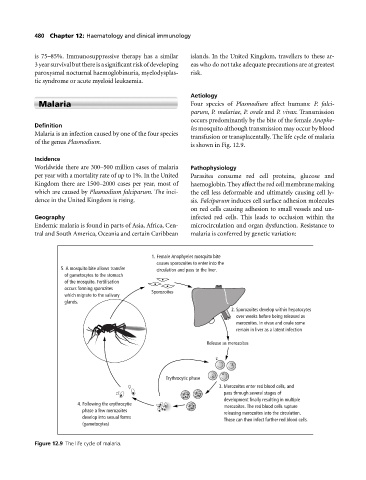Page 484 - Medicine and Surgery
P. 484
P1: KOA
BLUK007-12 BLUK007-Kendall May 12, 2005 20:37 Char Count= 0
480 Chapter 12: Haematology and clinical immunology
is 75–85%. Immunosuppressive therapy has a similar islands. In the United Kingdom, travellers to these ar-
3year survival but there is a significant risk of developing eas who do not take adequate precautions are at greatest
paroxysmal nocturnal haemoglobinuria, myelodysplas- risk.
tic syndrome or acute myeloid leukaemia.
Aetiology
Malaria Four species of Plasmodium affect humans: P. falci-
parum, P. malariae, P. ovale and P. vivax.Transmission
occurs predominantly by the bite of the female Anophe-
Definition
les mosquito although transmission may occur by blood
Malaria is an infection caused by one of the four species
transfusion or transplacentally. The life cycle of malaria
of the genus Plasmodium.
is shown in Fig. 12.9.
Incidence
Worldwide there are 300–500 million cases of malaria Pathophysiology
peryear with a mortality rate of up to 1%. In the United Parasites consume red cell proteins, glucose and
Kingdom there are 1500–2000 cases per year, most of haemoglobin. They affect the red cell membrane making
which are caused by Plasmodium falciparum.The inci- the cell less deformable and ultimately causing cell ly-
dence in the United Kingdom is rising. sis. Falciparum induces cell surface adhesion molecules
on red cells causing adhesion to small vessels and un-
Geography infected red cells. This leads to occlusion within the
Endemic malaria is found in parts of Asia, Africa, Cen- microcirculation and organ dysfunction. Resistance to
tral and South America, Oceania and certain Caribbean malaria is conferred by genetic variation:
1. Female Anophyeles mosquito bite
causes sporozoites to enter into the
5. A mosquito bite allows transfer circulation and pass to the liver.
of gametocytes to the stomach
of the mosquito. Fertilisation
occurs forming sporozites
Sporozoites
which migrate to the salivary
glands.
2. Sporozoites develop within hepatocytes
over weeks before being released as
merozoites. In vivax and ovale some
remain in liver as a latent infection
Release as merozoites
Erythrocytic phase
3. Merozoites enter red blood cells, and
pass through several stages of
development finally resulting in multiple
4. Following the erythrocytie
merozoites. The red blood cells rupture
phase a few merozoites
releasing merozoites into the circulation.
develop into sexual forms These can then infect further red blood cells.
(gametocytes)
Figure 12.9 The life cycle of malaria.

